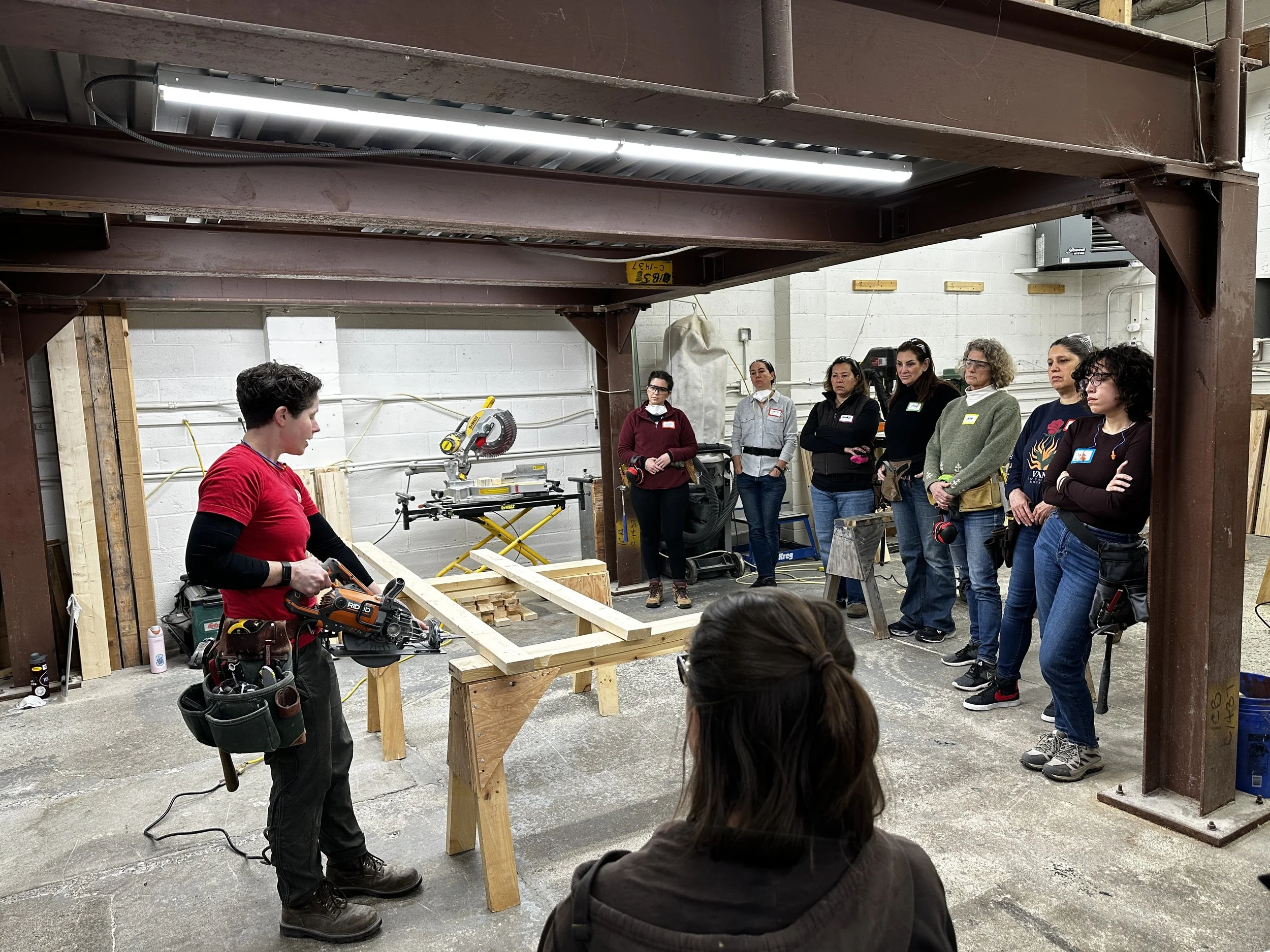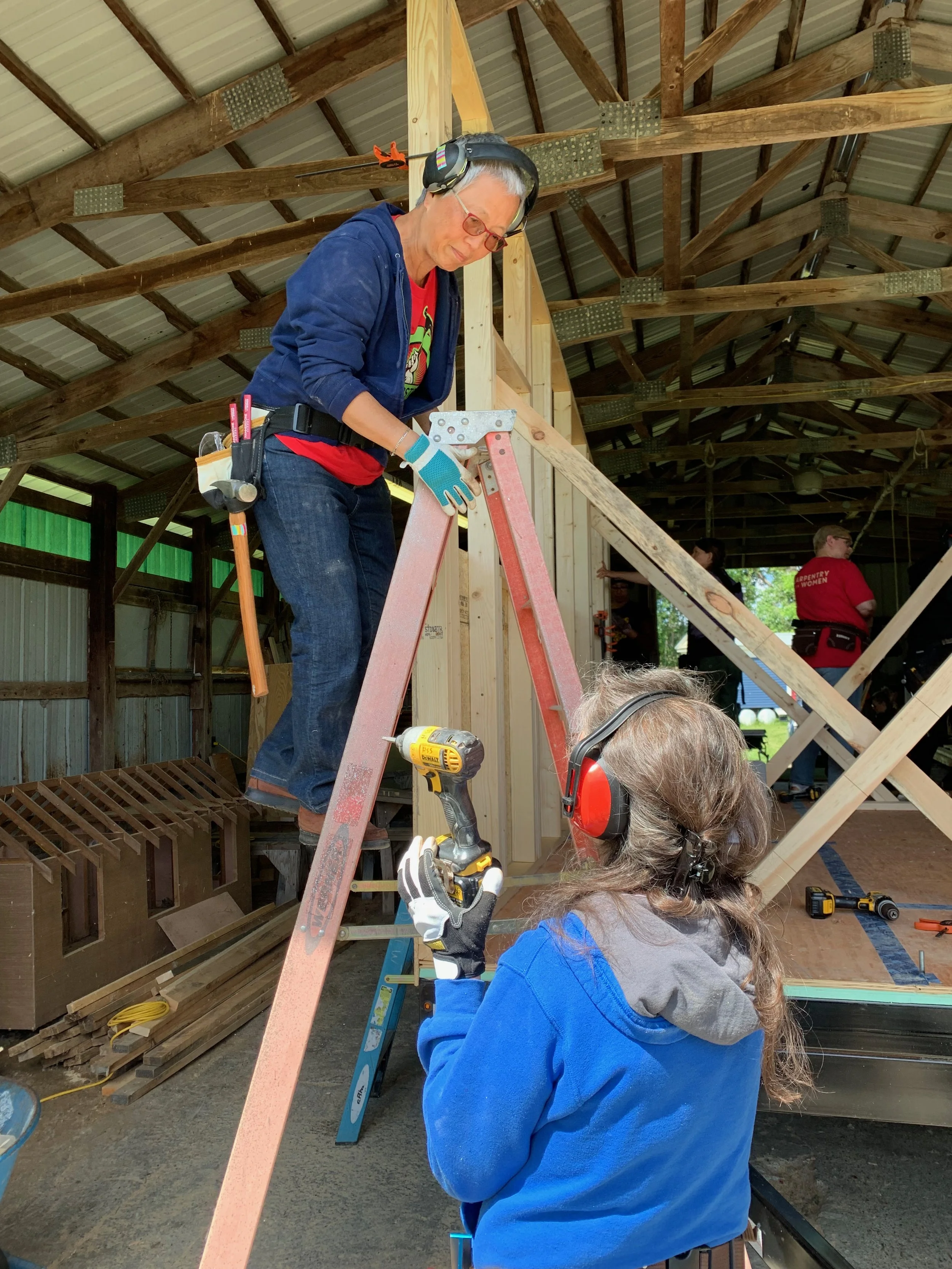Starting with Fears
Fears can consume us. Fears can hold us back from trying something new. Fears can keep us from going back to something we have previously failed at. Fears have power… if we give it to them.
One way to take away power from our fears is to define them, to give them a name, to say them out loud. This helps to process the emotions surrounding the fear and to gain clarity about where this fear is coming from.
On the first day of every Hammerstone class we start off with introductions. A simple round robin of who's who: name, where you're from, occupation, motivations for taking the class, and any previous carpentry experience. We love getting to know people and making connections based on everyone’s introductions before we dive into construction. But we also invite people to answer one final question:
"Do you have any fears or apprehensions regarding this carpentry class, but also, life in general?"
Christina shows a Basic Skills 101 class the safe use of a worm drive circular saw.
This lighthearted addition of "life in general" always generates a little laughter, and it opens up people's minds to what other fears might be weighing them down. This touches on a secret about Hammerstone:
we may be explicitly facing fears of power tools and ladders, but the confidence we gain in these realms carries over into our whole lives.
In our intros, we hear about hesitations regarding math and fractions, perfectionism, not having the stamina to do this work, messing up, forgetting, or not getting to use these skills again beyond class. So many of the fears students bring up come from the deep-seated thoughts and ideals that have been ingrained in us.
Using the right type of ladder for the job, inspecting before use, and maintaining three points of contact while climbing and working ensures proper ladder safety while working.
When I was growing up, well-meaning people would say “be careful” as I was about to do something that involved some risk. Although it seems nice to show someone you care about their wellbeing, this pervasive statement led me to second guess myself. Would I hurt myself? Would I do it right? Having a fear-filled approach to a task consumed my focus. It began to bleed into everything I did: even if no one was around to say “be careful,” I felt it nonetheless and I’d wonder if I should even try.
As I matured, I began to recognize the difference between listening to fear-filled thoughts - “They said you should be careful...are you sure you can even do this?” - and listening to your brain and gut combining to alert you - “Hold on, this isn't safe. Try a different way.”
In class, we absolutely encourage our students to rely on their knowledge and listen to their instincts while striving to hush the voices that have no purpose other than to sow doubt. In the classes I teach, I have replaced the phrase “be careful” with “be aware.” Saying “be aware” to someone shows that you have confidence that they have heard the information you’ve given them – that you have trust in them to take all of the information and employ it to do the task safely. It's a cue for their brain to review key points before engaging, instead of questioning their abilities.
Some folks wonder why we ask this question about our fears going into class. They speculate that we ask it because we're stereotypically touchy-feely. Are we perpetuating the "be careful" fear cycle? And the answer to that is simply…nope! In fact, we believe this question and its answers do the exact opposite.
When we speak our fears aloud it does a few things. First, it allows us to put a period at the end of the sentence. "I have anxiety about using a circular saw." Now it exists in a finite amount of space instead of swirling around in our head, gaining speed and size, popping into our thoughts at the most inopportune times. Second, it allows others to support us. When classmates and instructors hear the statement of a fear out loud, they have a definitive statement from which to work. We know they will be nearby ready to support us as we try something new, and that sense of security builds confidence. And finally, it opens up the opportunity for others to say, "me too, I have that same fear," and we find ourselves on a more level playing field than we once thought.
Being a first-time student showing up for acarpentry class may not seem like that big of a deal, but it’s an act that can be fully charged with overcoming fears—individual or cultural—to move in the direction of confidence, self-sufficiency, creativity, and community (to name a few).
Starting with fears does not make us afraid of what’s ahead. It allows us to acknowledge them so we can learn to trust our inner voices, support one another, practice our skills with clear heads, and grow.
All of our classes offer the opportunity to transform your fears into healthy respect and awareness, however, there are two classes in particular, Table Saw Fundamentals, and Intro to Electric, that always have students overcome a lot of external fear-mongering. The table saw and electricity are, justifiably, some of the most dangerous things we approach as carpenters. But being told “that’s dangerous, you shouldn’t do it,” leaves you without the opportunity to harness the great power afforded by these two skills. First and foremost in these classes, we address safety, knowing your personal limits, and when to call a professional. But beyond that, we train your awareness to build your capacity through understanding and practice.


